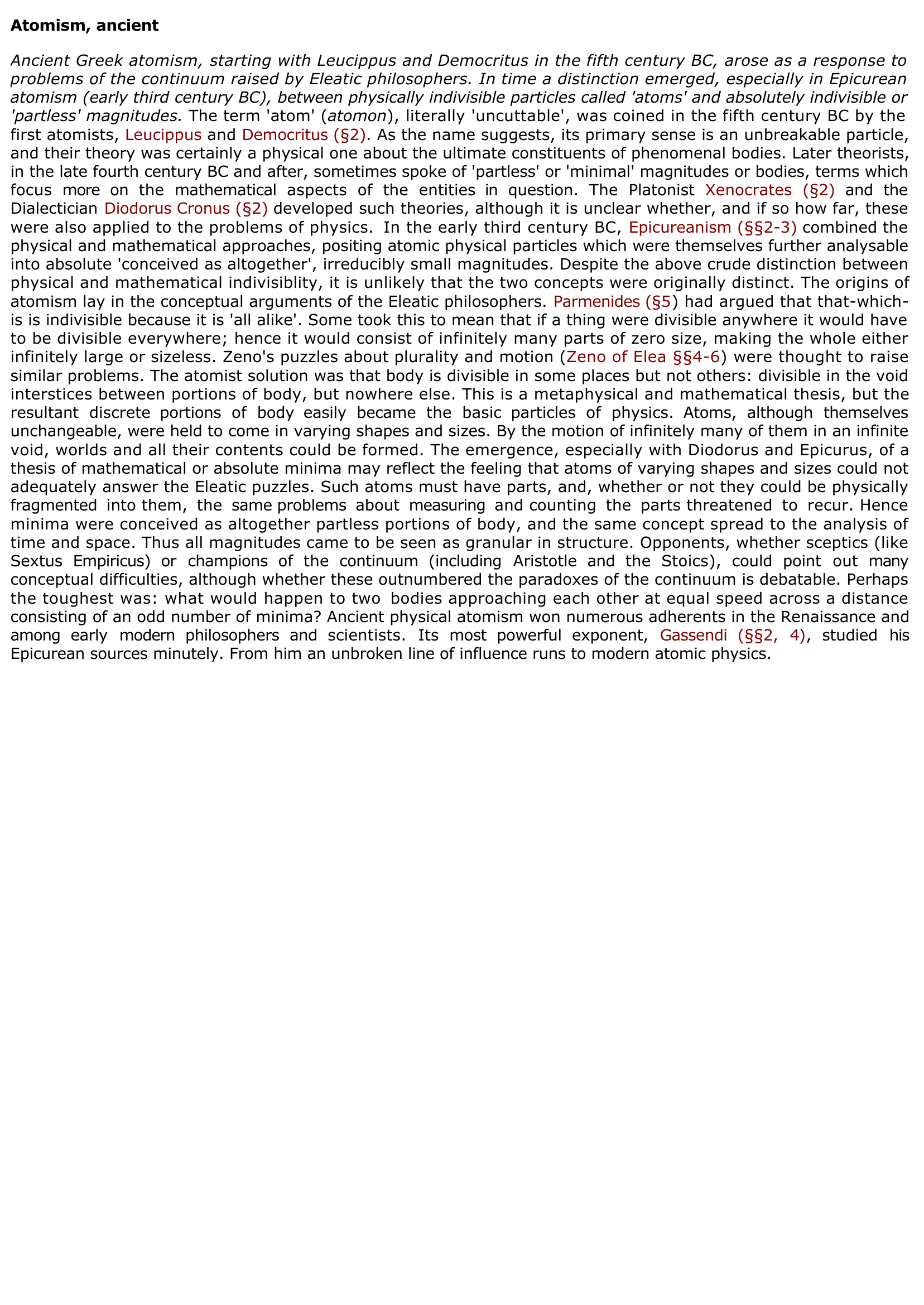Atomism, ancient
Extrait du document
«
Atomism, ancient
Ancient Greek atomism, starting with Leucippus and Democritus in the fifth century BC, arose as a response to
problems of the continuum raised by Eleatic philosophers.
In time a distinction emerged, especially in Epicurean
atomism (early third century BC), between physically indivisible particles called 'atoms' and absolutely indivisible or
'partless' magnitudes.
The term 'atom' (atomon), literally 'uncuttable', was coined in the fifth century BC by the
first atomists, Leucippus and Democritus (§2).
As the name suggests, its primary sense is an unbreakable particle,
and their theory was certainly a physical one about the ultimate constituents of phenomenal bodies.
Later theorists,
in the late fourth century BC and after, sometimes spoke of 'partless' or 'minimal' magnitudes or bodies, terms which
focus more on the mathematical aspects of the entities in question.
The Platonist Xenocrates (§2) and the
Dialectician Diodorus Cronus (§2) developed such theories, although it is unclear whether, and if so how far, these
were also applied to the problems of physics.
In the early third century BC, Epicureanism (§§2-3) combined the
physical and mathematical approaches, positing atomic physical particles which were themselves further analysable
into absolute 'conceived as altogether', irreducibly small magnitudes.
Despite the above crude distinction between
physical and mathematical indivisiblity, it is unlikely that the two concepts were originally distinct.
The origins of
atomism lay in the conceptual arguments of the Eleatic philosophers.
Parmenides (§5) had argued that that-whichis is indivisible because it is 'all alike'.
Some took this to mean that if a thing were divisible anywhere it would have
to be divisible everywhere; hence it would consist of infinitely many parts of zero size, making the whole either
infinitely large or sizeless.
Zeno's puzzles about plurality and motion (Zeno of Elea §§4-6) were thought to raise
similar problems.
The atomist solution was that body is divisible in some places but not others: divisible in the void
interstices between portions of body, but nowhere else.
This is a metaphysical and mathematical thesis, but the
resultant discrete portions of body easily became the basic particles of physics.
Atoms, although themselves
unchangeable, were held to come in varying shapes and sizes.
By the motion of infinitely many of them in an infinite
void, worlds and all their contents could be formed.
The emergence, especially with Diodorus and Epicurus, of a
thesis of mathematical or absolute minima may reflect the feeling that atoms of varying shapes and sizes could not
adequately answer the Eleatic puzzles.
Such atoms must have parts, and, whether or not they could be physically
fragmented into them, the same problems about measuring and counting the parts threatened to recur.
Hence
minima were conceived as altogether partless portions of body, and the same concept spread to the analysis of
time and space.
Thus all magnitudes came to be seen as granular in structure.
Opponents, whether sceptics (like
Sextus Empiricus) or champions of the continuum (including Aristotle and the Stoics), could point out many
conceptual difficulties, although whether these outnumbered the paradoxes of the continuum is debatable.
Perhaps
the toughest was: what would happen to two bodies approaching each other at equal speed across a distance
consisting of an odd number of minima? Ancient physical atomism won numerous adherents in the Renaissance and
among early modern philosophers and scientists.
Its most powerful exponent, Gassendi (§§2, 4), studied his
Epicurean sources minutely.
From him an unbroken line of influence runs to modern atomic physics..
»
↓↓↓ APERÇU DU DOCUMENT ↓↓↓

































